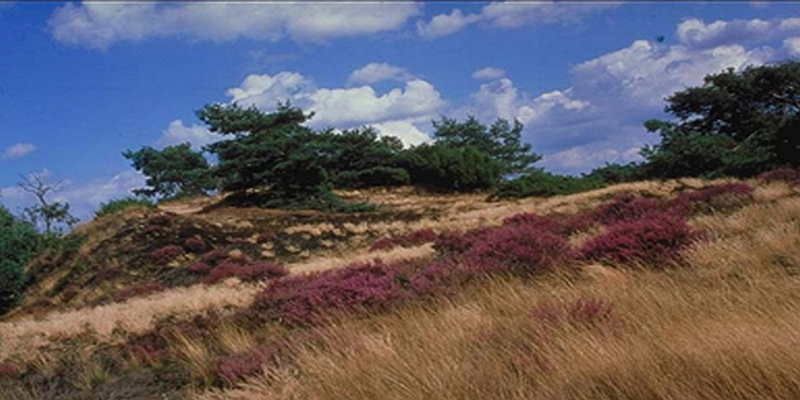
Eco-evolutionary feedbacks in habitats at a regional scale
It is well established that different biogeographic regions may harbor different levels of macro-evolutionary diversification possibly reflecting the regional environments. In this project we study levels of macro-evolutionary diversification and eco-evolutionary feedbacks within a region. We analyzed the world’s largest vegetation-plot database and a new, uniquely resolved dated angiosperm phylogeny available for the Netherlands. We characterized species pools of habitat types by a novel concept: epoch-specific lineage diversifications. We showed that even within a region particular habitat types along environmental gradients sort much higher levels of evolutionary diversification from the regional pool than others, without sorting more species. This uneven sorting of macroevolutionary diversification by habitats is much stronger than the well established habitat-sorting of species diversity. Using this conceptual approach, we further suggest that entire phylogenetic clades may persist within a region because species within these clades use similar habitats, and ecological similarity within clades may increase the degree of co-occurrence of species within clades. We show that in clades, in which species occupy similar habitats, species tend to exhibit increased co-occurrence, mutualism, niche expansion, and hybridization – and they rarely decline. Consistently, throughout the geological past, clades whose species occupied similar habitats often persisted through long time-spans. Overall, for many plant species, the occupation of similar habitats among fellow clade members apparently reduced their vulnerability to environmental change.
Photo (Genisto anglicae-Callunetum habitat type) was obtained from SynBioSys Netherlands version 3.3.3 produced by Dr. Stephan Hennekens, with his permission.
Photo by R. Knol (fotonr. 02006)
Collaboration:
Andreas Prinzing; Francoise Hennion; Benjamin Yguel from University Rennes, Centre National de la Recherche Scientifique, Research Unit Ecosystèmes Biodiversité, Evolution, Rennes, France
Wim A. Ozinga from Wageningen Environmental Research (Alterra), Wageningen; Experimental Plant Ecology, Radboud University Nijmegen, Nijmegen, The Netherlands
Pille Gerhold from Department of Botany, Institute of Ecology and Earth Sciences, University of Tartu, Tartu, Estonia
Publications:
Barbe L., Mony, C., Vincent, J., Santonja, M., Bartish, I.V., Prinzing, A. (2018) Functionally or phylogenetically distinct neighbors turn antagonism among decomposing litter species into synergy. Journal of Ecology, 106 (4):1401-1414) https://doi.org/10.1111/1365-2745.12944
Prinzing A., Ozinga, W.A., Brändle, M., Courty, P.-E., Hennion, F., Labandeira, C., Parisod, C., Pihain, M., Bartish, I.V. (2017) Benefits from living together? Clades those species use similar habitats might persist due to eco-evolutionary feedbacks. New Phytologist, 213 (1): 66-82. https://doi.org/10.1111/nph.14341
Yguel, B., Jactel, H., Pearse, S.I., Moen, D., Winter, M., Hortal, J., Helmus, R.M., Kühn, I., Pavoine, S., Purschke, O., Weiher, E., Violle, C., Ozinga, W., Brändle, M., Bartish, I.V., Prinzing, A. (2016) The evolutionary legacy of diversification predicts ecosystem function. American Naturalist, 188 (4): 398-410. https://doi.org/10.1086/687964
Hennion, F., Litrico, I., Bartish, I.V., Weigelt, A., Bouchereau, A., Prinzing, A. (2016) Ecologically diverse and distinct neighbourhoods trigger persistent phenotypic consequences, and amine metabolic profiling detects them. Journal of Ecology, 104 (1): 125-137. https://doi.org/10.1111/1365-2745.12505
Prinzing, A., Powrie, L.W., Hennekens, S.M., Bartish, I.V., Ozinga, W.A. (2016) “High-co-occurrence genera”: Weak but consistent relationships with global richness, niche partitioning, hybridization and decline. Global Ecology and Biogeography, 25 (1): 55-64. https://doi.org/10.1111/geb.12385
Pan, X., Berg, M.P., Butenschoen, O., Murray, P.J., Bartish, I.V., Cornelissen, J.H.C., Dong, D., Prinzing, A. (2015) Larger phylogenetic distances in litter mixtures – lower microbial biomass and higher C/N ratios but equal mass loss. Proceedings of the Royal Society B, 282 (1806); https://doi.org/10.1098/rspb.2015.0103
Gerhold, P., Cahill, J. F., Winter, M., Bartish, I.V., Prinzing, A. (2015) Phylogenetic patterns are not proxies of community assembly mechanisms (they are far better). Functional Ecology, 29 (5), 600-614. https://doi.org/10.1111/1365-2435.12425
Ozinga, W. A., Colles, A., Bartish, I.V., Hennion, F., Hennekens, S. M., Pavoine, S., Poschlod, P., Hermant, M., Schaminée, J. H. J., Prinzing, A. (2013) Specialists leave fewer descendants within a region than generalists. Global Ecology and Biogeography, 22 (2): 213-222. https://doi.org/10.1111/j.1466-8238.2012.00792.x
Hermant, M., Hennion, F., Bartish, I.V., Yguel, B., Prinzing, A. (2012) Disparate relatives: Life histories vary more in genera occupying intermediate environments. Perspectives in Plant Ecology Evolution and Systematics, 14 (4): 283-301. http://dx.doi.org/10.1016/j.ppees.2012.02.001
Gerhold, P., Pärtel, M., Tackenberg, O., Hennekens, S., Bartish, I.V., Schaminée, J. H. J., Fergus, A. J. F., Prinzing, A. (2011) Phylogenetically poor plant communities receive more alien species, which more easily coexist with natives. American Naturalist, 177 (5): 668-680. https://doi.org/10.1086/659059
Bartish I.V., Hennekens, S., Aidoud, A., Hennion, F., Prinzing, A. (2010) Species pools along contemporary environmental gradients represent different levels of diversification. Journal of Biogeography, 37 (12): 2317-2331. https://doi.org/10.1111/j.1365-2699.2010.02382.x

